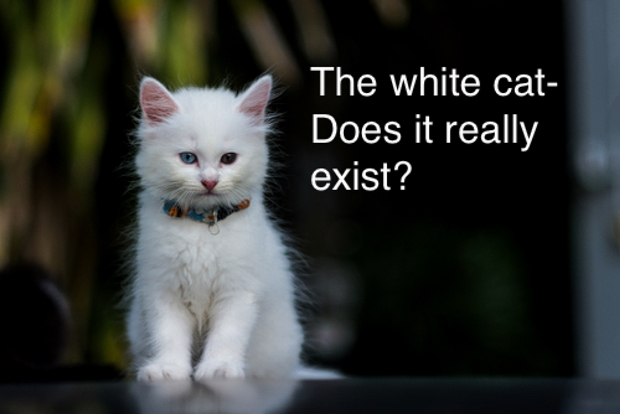
Photos courtesy of Long Beach Animal Hospital.
If you have a white cat, it may shock you to discover that he or she isn’t really white—in fact, you might say there’s really no such thing as a white cat! White isn’t really a color—it’s the expression of a gene that masks, or covers, the underlying color. So, every white cat really has a true color that has been completely masked or covered by the white spotting gene (WSG). What you really have is a red cat or a brown tabby or a black or a tortoiseshell whose pigment has been suppressed by this gene and appears white because there’s no pigment in the hair. The effects of this gene start at the extremities, and move up toward the center of the body, with stronger and stronger expressions of the gene.
Imagine a litter of five kittens who are black and white, each having a varying effect of the WSG: one is black with white feet and a white blaze on the nose. Another is black, with long white stockings, a white face and a white belly. Another is about half black and half white, in patches. Another is mostly white, with a few black spots on the head and tail. And the last one is pure white, with blue eyes. This imaginary litter shows the range of effects from the WSG, from the first who is mostly black with a little white to a pure white cat with blue eyes—he’s really a black cat but has no pigment because the WSG is fully expressed. The question is, is he able to hear?
Why Are Blue-Eyed White Cats Often Deaf?
In the case of our imaginary white kitten in the litter of black-and-whites, the WSG has turned off all pigment, including the eyes. The blue of blue eyes is actually a structural color and not a pigment (the same is true for people). During embryonic development, prototype nervous-system cells follow the migration of pigment cells, which is especially important for the auditory center of the brain. Without pigment cells to follow, the nerve cells may not complete their migration very well, resulting in an underdeveloped auditory center and a deaf cat. (Some might say that most cats have selective hearing anyway!)
Flicka and Tortilla: The Genetics of Color
Flicka and Tortilla are sisters (littermates) and are an excellent illustration of the WSG. Tortilla the tortoiseshell is blue and cream instead of red and black, making her a dilute tortoiseshell. She has no white on her at all, so the WSG has passed her by, and the cream and blue colors are in speckles all over her body. The cream blaze on her face is commonly seen in tortoiseshells and calicos, giving her face a “half-and-half” effect.
The WSG is well expressed on Flicka, whose body is mostly white, with color on her head and tail only. These cream and blue patches give away her true color, which is dilute tortoiseshell, just like her sister. But an interesting thing happens with the WSG when you add it to a tortoiseshell: once more than a third of the body is white, the speckles and little spots of the tortoiseshell become organized into large patches. That’s why you won’t see a half white/half tortoiseshell: the larger patches now make this into a calico (black, red and white, or the dilution, which is blue, cream and white).

Flicka, flecked with her patches.
Flicka cannot be a “tortoiseshell and white” because her body is about 80 percent white, so the color is in larger patches, not little speckles. Technically, she is a dilute van calico, the van indicating that she is mostly white. The white color—really an absence of pigment—has nearly taken over her whole coat, leaving color only on the head and tail. This follows a pattern—you may see a van cat with color on the head and tail or with an extra patch on the back, but you would never see a mostly white cat with black feet. The effects of the WSG start at the extremities and extend inward. (This is different from the Siamese coloring—that’s Loki’s story, coming soon.)
You would never see a van tortoiseshell—it will always be a van calico because of this interesting effect from the WSG. The dilute van calico is a very unusual color and pattern (and Flicka knows she’s special!).

Tuxie!
The black-and-white kittens in our imaginary litter would be called black-and-white bicolors, and the one with just a little black on his head and tail would be a black and white van bicolor, indicating that he is mostly white. The two black kittens who have white faces, necks, bellies and legs are called, charmingly, tuxedos.
The genetics of color in cats is fascinating and a whole lot more than just a tabby or a gray or a white cat—which, remember, doesn’t really exist!

